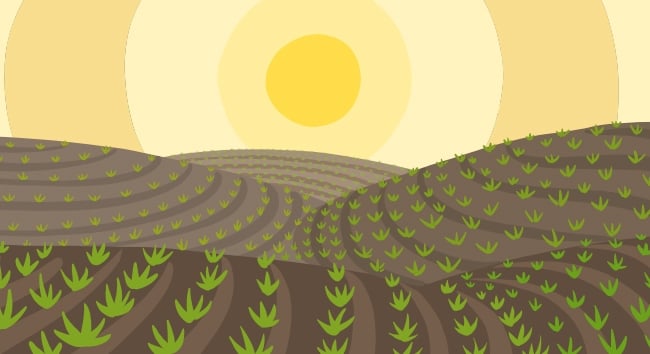Plowing Ahead: Check Out These Odd And Out-Of-The-Box alternative Crops

Some farmers are content with milking cows or growing corn and soybeans. But what if you want to try your hand at producing a more unusual crop or agricultural product? We looked far and wide for the weirdest, wildest, and most-trailblazing 21st century options for the nontraditional farmhand. Here’s what we found.
Can You Stand The Heat?
Do you want to spice up your agricultural life? Then you can be like Ed Currie, a farmer who devotes his life to growing the hottest chili peppers known to mankind. His Carolina Reaper is considered the hottest pepper variety in the world. This potent pod registers a scorching 1.6 million heat units on the Scoville scale (a measure of concentration of capsaicin—the compound that makes peppers taste spicy), which makes the 3,000 units of heat in the jalapeño seem like nothing.
Through his Rock Hill, South Carolina-based company, Puckerbutt Pepper Company, Currie raises 200,000 plants from greenhouse to field. Some 20 workers pick the peppers by hand and deliver them to a processing facility where they are converted to a pepper mash and then used in a variety of products. The farm sources peppers for many hot sauce manufacturers and sells packs of 10-12 seeds for $7 a piece to anyone who would dare to start growing their own.

In 2013, Currie crossbred a super-hot Caribbean pepper with a Naga pepper from Pakistan to create the Reaper, and since that time, he has held the Guinness World Record for the hottest pepper. But, despite this achievement, Currie is ever striving to concoct new varieties.
Breeding Bloodsuckers
You thought leech therapy was oh so 19th century? Well, guess again. While bloodletting is no longer considered a cure for a wide variety of ailments, medical researchers are developing new uses for the wiggly little bloodsuckers, and the US Food and Drug Administration now allows companies to market them as “medical devices.” The saliva of leeches contains a natural anticoagulant called hirudin. This relative to the earthworm can be used to encourage blood flow in damaged human tissue, and, as a result, leeches are commonly used in limb-reattachment procedures.
Medical revelations regarding leeches have led to a niche interest in leech farming, though only one operation, Biopharm, based in Wales, currently corners the market in lucrative medical-grade leech production. That’s probably because farming leeches is a lot more complicated than you might expect. The leeches are grown in a climate-controlled, sterile tank, and the process as a whole takes three to four years. They are alternately fed sheep’s blood in a sausage casing for six months and then starved for six months, to then be carefully shipped good and hungry to the end user.
A US-based company called Leeches USA sells medicinal leeches for about $18 each. But the leeches can only be used once on one patient and then must be discarded as biohazard material to prevent blood from one patient being transferred to another.
Feed Me, Seymour
Like the giant killer plant you may remember from Little Shop of Horrors, futuristic farmer Peter D’Amato envisioned a landscape full of beautiful, flesh-eating flora and made his dream come true with his plant farm named California Carnivores. In a rural area north of San Francisco, D’Amato’s team of botanists tend to 500 varieties of meat-eating plants that will devour everything from the tiniest gnat to small rodents.
D’Amato started the plant farm in 1989 and has devoted nearly 50 years to the study and hybridization of carnivorous plants as cofounder of the Bay Area Carnivorous Plant Society. What is more is that he is happy to help you develop a green thumb with these bug-eaters, having published the popular book, The Savage Garden: Cultivating Carnivorous Plants.

And you, too, can join in the twisted farming fun by buying and growing your own predatory plants.
Everyone knows about the Venus flytrap, native only to the US Carolinas, which snaps its toothy jaws around unsuspecting prey. Or the American pitcher plant, which victims to a terrible death in a fount of gooey poison. And don’t forget the sundew plant that rolls its sticky tentacles around insects and extracts the life out of them. It’s creepy and fascinating to see them at work—the only plants you can watch move on their own.
Underwater Bounty
Seaweed promises to be a miracle crop that will have many agriculture entrepreneurs casting their gaze to the ocean as a new farming frontier. Cultivating the wavy green strands of plant material is relatively easy and inexpensive and can be done using a very small area of water—even just 10 acres could yield a good profit. Seaweed is farmed worldwide, with farmers on both US coasts leasing the waters from local, state, or federal governments, and growing the weeds on long rope lines suspended underwater. The lines need regular tending, but within a matter of a few months, seaweed grows to several feet long and is thus harvested.
Seaweed is said to be one of the most nutrient-dense food sources available. Various types, such as dulse, bull kelp, ribbon kelp, and sugar kelp, are used in many food products, including sushi, salsas, and salads. As a foodstuff, seaweed includes antioxidants, omega-3 fatty acids, iron, calcium, and iodine. Beyond just food products, though, experts say the plants can be used to make clothing, alternative plastic packaging, biodegradable bottles, animal feed, soil input, and pharmaceuticals.
Join The Discussion!
Do you like hot sauce or hot peppers?
How about seaweed?
Have you ever owned a Venus flytrap before?
What alternative agricultural product interests you most?
Let us know in the comments below!
We are looking forward to hearing from you.

Jim Kneiszel
Jim Kneiszel is a freelance writer based in De Pere, Wisconsin. He edits a number of trade publications and runs The Word House with his wife, Judy. His article, Infuriating and Frightening Invasive Species appears in the 2021 Farmers' Almanac.







I would love to farm but only have 1 acre. Any small farming ideas?
This was really interesting! I didn’t know you could use seaweed as an alternative plastic. It didn’t say if it was more biodegradable than current plastics, but I am hoping so. We need to stop/reduce plastic production. Thanks for a great article.
Great article, thank you! I regularly eat seaweed, love it.
I love to try my hands on growing the hottest pepper here in London. I do my peppers on my windows as peppers do not seem to like the cold outdoor of our allotments. It will be most exciting. How can I get some seeds for next season?
Daniel
Hi Daniel,
We do list the farm’s web site – https://puckerbuttpeppercompany.com/ – not sure if he sells his seeds or can ship to London, but you may want to contact them.
It would be super to find a plant which will eat those large roaches politely called “palmetto” bugs!
Now that would be a successful farming project!
I love it, new thinking, new visions,